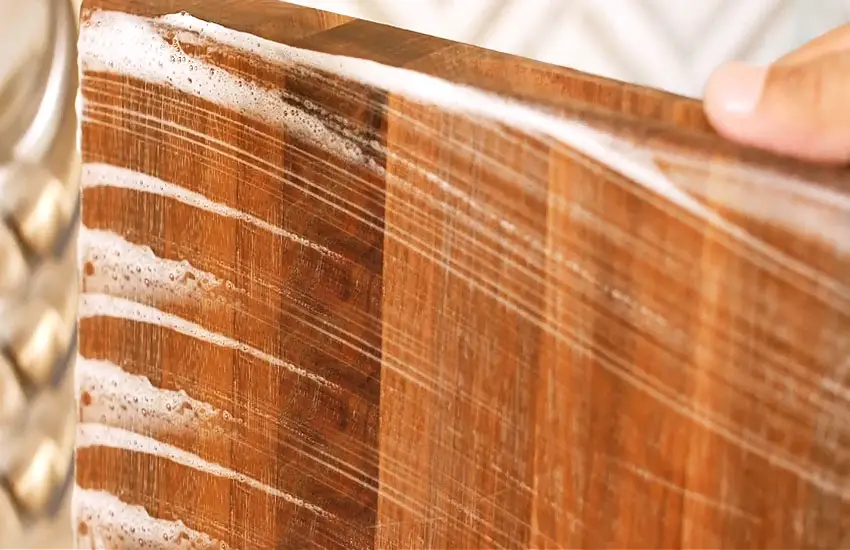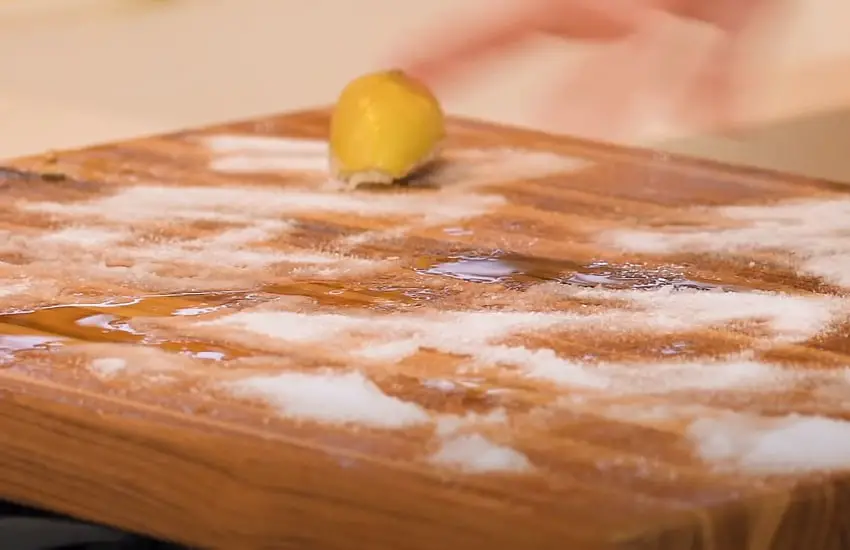As an Amazon Associate, I earn from qualifying purchases at no extra cost to you.
Easy Way to Clean Wooden Cutting Board: The Ultimate Guide
Keeping your wooden cutting board clean is important for your health and the longevity of the board. In this blog post, we’ll explore simple steps to help you keep your wooden cutting board sparkling clean.
Wooden cutting boards can harbor bacteria if not cleaned properly, so it’s essential to follow the right methods. We’ll discuss how to clean your board using basic household items like soap, water, and vinegar. These ingredients are gentle yet effective in removing food particles and germs.
We’ll also cover tips on how to properly dry and store your wooden cutting board to prevent warping and cracking. By following these steps regularly, you can ensure that your cutting board remains safe to use and lasts for years to come.
Whether you’re a seasoned chef or just starting in the kitchen, learning how to clean your wooden cutting board properly is a valuable skill that will contribute to a clean and healthy cooking environment. Let’s get started!

Why Cleaning A Wooden Cutting Board Is Important
Wooden cutting boards are a staple in many kitchens due to their durability and natural antimicrobial properties. However, regular cleaning and maintenance are crucial to ensure the safety of the food prepared on them and to extend their lifespan.
Preventing Bacterial Growth
Proper cleaning of wooden cutting boards is essential to prevent the accumulation of harmful bacteria. The organic nature of wood makes it susceptible to retaining food particles and moisture, creating an ideal environment for bacteria to thrive. Routine cleaning helps eliminate these contaminants and reduces the risk of foodborne illnesses.
Preserving The Board’s Lifespan
Regular cleaning not only safeguards against bacterial growth but also plays a key role in preserving the quality and longevity of wooden cutting boards. Moisture, stains, and odors can compromise the integrity of the wood over time. By maintaining a clean and dry surface, you can prevent warping, cracking, and other forms of damage, thereby extending the lifespan of the board.
Essential Tools And Materials For Cleaning
When it comes to cleaning your wooden cutting board, having the right tools and materials is essential. To ensure proper hygiene and maintain the longevity of your cutting board, consider the following:
Dish Soap And Warm Water
Start by mixing a few drops of mild dish soap with warm water. Gently scrub the cutting board using a sponge or a soft-bristle brush. Rinse thoroughly with warm water to remove any soap residue, and pat it dry with a clean towel. Avoid using harsh detergents or soaking the cutting board for prolonged periods, as this can cause damage.
White Vinegar Solution
If you prefer a natural cleaning solution, white vinegar can be highly effective. Mix equal parts of white vinegar and warm water. Dampen a clean cloth or sponge with the solution and wipe down the entire surface of the cutting board. The acetic acid in vinegar works to disinfect and remove odors. Rinse the cutting board with warm water and dry it thoroughly.
Baking Soda Paste
Baking soda is a fantastic natural cleaner and deodorizer. To create a paste, mix baking soda with a small amount of water until it forms a thick consistency. Gently scrub the cutting board using the paste and a sponge or brush. The abrasive properties of baking soda help remove stains and grime. Rinse well with warm water and dry it completely.
Lemon Juice
Lemons not only add a refreshing flavor to dishes but can also be used for cleaning. Cut a lemon in half and squeeze the juice onto the cutting board. Use the lemon halves to rub the juice into the surface, focusing on any stubborn stains or odors. Allow the juice to sit for a few minutes before rinsing with warm water. The natural acidity of lemons helps break down grease and sanitize the cutting board.
Food-grade Mineral Oil
To keep your wooden cutting board in optimal condition, it’s important to provide it with regular nourishment. Food-grade mineral oil is a great option for moisturizing and preserving the wood.
Apply a small amount of oil to a clean cloth and then rub it into the entire surface of the cutting board, focusing on any dry or damaged areas.
Allow the oil to penetrate for at least 20 minutes, or overnight for better absorption, before wiping away any excess oil. Regular oiling can prevent the wood from drying out and help maintain its natural beauty.
Step-by-Step Cleaning Process
We will guide you through the entire cleaning process, from scraping off excess food debris to refreshing with lemon juice and applying food-grade mineral oil.

Scrape Off Excess Food Debris
To begin the cleaning process, start by scraping off any excess food debris from your wooden cutting board using a plastic scraper or a blunt knife. Be gentle to avoid damaging the surface of the board. Scratching away food particles not only ensures a cleaner board but also helps in preventing the growth of bacteria.
Wash The Board With Soap And Water
After removing the excess debris, it’s time to wash the cutting board with soap and water. Using a mild dish soap, create a soapy solution by adding a few drops of soap to warm water in a sink or basin.
Place the wooden cutting board in the soapy water and scrub it gently using a sponge or a soft-bristle brush. Make sure to clean both sides of the board thoroughly, covering all the surface areas.
Disinfect The Board With Vinegar Solution
To ensure complete disinfection, it’s crucial to use a vinegar solution. In a spray bottle, mix equal parts of white vinegar and water. Spray the solution generously onto the entire surface of the cutting board, and let it sit for a few minutes.
Vinegar acts as a natural disinfectant and helps to eliminate any remaining bacteria or germs on the board. After allowing the solution to sit, rinse the cutting board thoroughly with water to remove any vinegar residue.
Remove Stains With Baking Soda Paste
If your wooden cutting board has stubborn stains, a baking soda paste can come to your rescue. Sprinkle a small amount of baking soda on the stained areas and then add a few drops of water to create a paste-like consistency.
Gently rub the paste onto the stain using a soft cloth or sponge, applying light pressure. Allow the paste to sit on the stain for a few minutes, and then rinse the board well with water, ensuring all the baking soda residue is removed.
Refresh With Lemon Juice
For an extra burst of freshness, using lemon juice is highly beneficial. Cut a lemon in half and squeeze the juice onto the surface of the cutting board. Spread the juice evenly using the cut side of the lemon or a clean sponge.
Let the board absorb the lemon juice for a few minutes, as it acts as a natural deodorizer and helps eliminate odors. Afterward, rinse the board thoroughly with water to remove any lemon juice residue.
Apply Food-grade Mineral Oil
To maintain the longevity and appearance of your wooden cutting board, it’s crucial to apply a food-grade mineral oil. Using a clean cloth or paper towel, apply a generous coat of mineral oil to the entire surface of the board, including the sides.
Allow the oil to seep into the wood, providing nourishment and protection against moisture. Let the cutting board rest upright overnight to allow the oil to penetrate fully. Wipe off any excess oil before using the board for food preparation.
Proper Maintenance Tips for Wooden Cutting Boards
Keeping your wooden cutting board in good shape is like taking care of a friend – you want to make sure it stays happy and healthy for a long time. Here are some easy tips for keeping your cutting board in tip-top condition:
1. Clean After Each Use
After you finish using your cutting board, give it a good wash with warm, soapy water. Use a sponge or cloth to scrub away any food bits or stains. Rinse it well with clean water and dry it thoroughly with a towel. This will help prevent bacteria from growing on the surface.
2. Oil Regularly
To keep your cutting board well-nourished and protected, oil it regularly with food-grade mineral oil or another suitable oil. Apply a thin layer of oil to the surface of the cutting board and use a clean cloth to spread it evenly. Let the oil soak in for a few hours or overnight before wiping off any excess.
3. Remove Stains
If your cutting board develops any stubborn stains or odors, try scrubbing it with a mixture of salt and lemon juice or baking soda and water. These natural cleaners can help lift stains and neutralize odors without damaging the wood.
4. Avoid Soaking
While it’s important to clean your cutting board thoroughly after each use, avoid soaking it in water for long periods. Excessive moisture can cause the wood to warp or crack over time. Instead, wash your cutting board quickly and dry it right away.
5. Store Properly
When you’re not using your cutting board, store it in a cool, dry place away from direct sunlight and heat sources. Avoid leaning it against a wall or storing it flat on a countertop, as this can trap moisture and lead to warping. Instead, stand it upright or store it on its side to allow air circulation.
6. Sand and Refinish
Over time, your cutting board may develop scratches, dents, or rough spots. If this happens, you can sand it down lightly with fine-grit sandpaper to smooth out the surface. After sanding, apply a fresh coat of oil to protect the wood and restore its natural beauty.
By following these simple maintenance tips, you can ensure that your wooden cutting board stays clean, beautiful, and ready for all your culinary adventures. So, show your cutting board some love and keep it in great shape for years to come!
Conclusion
Cleaning your wooden cutting board is essential for preventing bacteria growth. Following the simple steps mentioned in this guide can help prolong the lifespan of your cutting board and ensure safe food preparation. By maintaining your wooden cutting board properly, you can enjoy using it for years to come.
